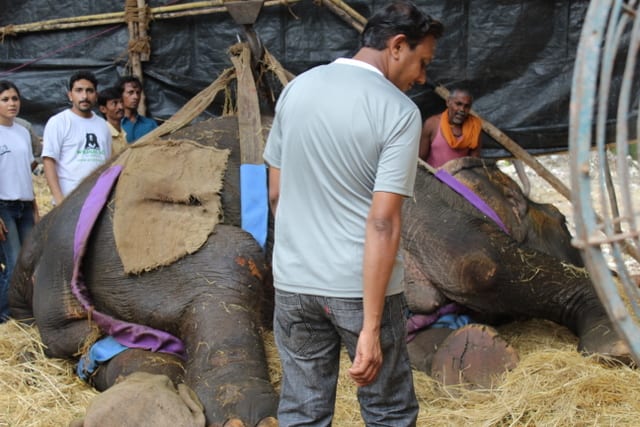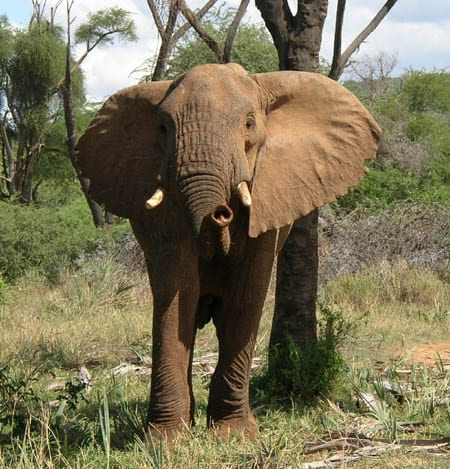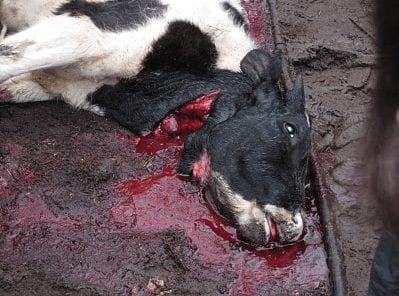Natural food sections in our grocery stores are chock full of them. The ethical foodies seek them out. They’re intended to inform the consumer about where our food comes from and how it’s produced: “Sustainable,” “organic,” “free-range,” “local” products — we’ve all seen the terms and we hope they genuinely convey what they imply.
But what do they really mean? What’s the truth behind the label? Can meat ever really be sustainable? Is purchasing local a good thing for the environment? Not always, says activist, author and educator Lee Hall, who serves as legal affairs VP for Friends of Animals. Hall is also an active supporter of HumaneMyth.org, a group that seeks to expose the facts behind our misleading food labels and farming practices.
I spoke with Hall, a CounterPunch writer and contributing editor, whose latest book on animal-rights theory and advocacy, On Their Own Terms: Bringing Animal-Rights Philosophy Down to Earth is out now.
Joshua Frank: As someone who frequently shops at farmer’s markets and natural food stores, I have noticed a rapidly growing trend toward so-called ethical eating. People are becoming aware of the dark side of industrialized farming, and as a result more and more animal products are being labeled with terms like “cage free,” “humane certified” and “organic.”
Lee Hall: You’re right; this trend is growing fast and the advertising hype that’s driven by enterprises such as Whole Foods have a lot to do with it, as does the reality that global warming really is upon us. Climate disruption is the most frightening thing since the bomb (and that’s not gone). People are looking for pacifiers. People want to be able to say they’ve grasped the inconvenient truth but they still want peace of mind. If they’ve got money, they’ll pay a bit more these days for that.
JF: But you’ve argued that these are simply marketing terms that do not necessarily mean what they convey to consumers. Can you explain why? What’s the reality behind these terms?
LH: First, they’re usually just marketing ploys. There’s no legally binding definition for cage-free eggs, for example. These items are bought by people who want to believe the birds were treated OK. That’s well-meaning. But think about what’s going on. Packing a mass of birds into a shed isn’t much better than jamming them into a cage. Cannibalism increases in shed situations where so-called cage-free chickens lay eggs, as does bone breakage. Recall that birds who are purpose-bred to lay eggs do that a lot. So they’re always short of calcium; it leaves their bodies and goes into the shells. That means osteoporosis is common in commercial birds. I don’t mean to be a party pooper here; I assure you there are great vegan recipes for just about anything you’re making with eggs now.
I know some people will say: Oh, but my eggs, my ham — it really does come from a good farm; look at their Web site and all the greenery! Well, you must have a lot of money to eat that way all the time. But even if the animal farms you support are spacious, think about the ramifications. More space for agribusiness concerns, less free animals in wild spaces. Just like suburban development, farms take up a lot of land. Why would we as a society continue to think this is a good trend?
JF: What about grass-fed cattle? Michael Pollan and others have touted the alleged environmental and ethical benefits of eating free-range beef as opposed to cows raised in CAFOs (confined animal feeding operations). Isn’t this method of raising animals qualitatively better?
LH: To my mind, Michael Pollan’s arguments are clever, but ultimately unconvincing. Eight years ago, Pollan wanted to be assured that eating the flesh of cattle could be done without barbarism. This was no easy feat. To prove the thesis of compassionate carnivorism, this contributing writer for the New York Times Magazine actually bought a calf. Pollan chronicled the growth of the little Black Angus steer from a nursing baby up until the end of it all. The animal was killed a few weeks after turning one year of age.
Do you remember the name Pollan referred to that calf by? Number 534. Compassionate, isn’t? Now we’re supposed to believe that there’s no ecological barbarism in eating these animals either — if it’s done on pastures, not in factories. Balderdash. As the human population continues to rise, as biofuels compete with agricultural land, as energy and water become concentrated in fewer hands, mass production will be the norm. Only a select few will have the opportunity to eat that grass-fed flesh Pollan’s touting.
And what happens to the wolves, coyotes, bobcats, and other animals who once roamed the land made over to farm sprawl?
If you really want to tread lightly on the earth and its conscious life, the answer is to stop breeding these poor beings only to betray them and stop annihilating wildlands for malls — and the farms too. There’s a great saying ascribed to Confucius: “The way out is via the door.”
JF: I’ve always been skeptical of the free-range cattle notion. Spending a considerable amount of time hiking around the rural West, I have seen many grass-fed cattle roaming our public lands and shitting in and around some of the state’s remaining wild rivers. A study by UC Davis Medical Center recently confirmed that free-roaming livestock are polluting rivers in the Sierras with their waste.
LH: That study is on to something: water on public lands and wilderness areas are dirtiest where cattle graze. And what a word from an ethical point of view. Livestock. Live today, stock tomorrow. It’s really a bane, this notion that conscious life can and should be a commodity. Imagine if we dared to challenge that. Environmental advocacy would be revolutionized overnight.
This is what the locavores aren’t talking about. Cows aren’t part of the natural biocommunity. As commercial cows became widespread, their free-living ancestors, the aurochs, went extinct in the seventeenth century, when a poacher shot the last one in Poland. Free-range? Not really. The ones we see today are purpose-bred animals, imposed on the land.
JF: Since you bring up the locavore movement, I’m reminded of Prof. James McWilliams at Texas State University who has argued that “If you want to make a statement, ride your bike to the farmer’s market. If you want to reduce greenhouse gases, become a vegetarian.” Why do you think the broader environmental movement has yet to fully embrace vegetarianism as one way to challenge climate change?
LH: Much of what we call the environmental movement relies on donations. So there’s a hydraulic pull to behave as though laws and lawmakers should fix things. That’s convenient. Potential donors aren’t challenged to make personal changes.
At the same time, the moneyed donors non-profits hope to attract will find comfort in promotions of “humane, sustainable, all-natural meat” and the like. Rarely do environmental groups ask potential supporters to begin with the personal, essential paradigm shift that a full vegetarian commitment involves.
What underlies this hesitance? Well, imagine the Catholic authorities’ initial resistance to the Copernican revolution. People had to leave their comfort zone to grasp the reality the universe does not revolve around the human being. Galileo got the picture, and wound up under house arrest.
Suggest that humans are part of the biocommunity rather than in charge of it? Say the universe does not revolve around us? Humanity is not quite ready to accept that reality — although everything from the climate to the extinction rate is telling us the time has come to do so.
JF: In 2006 the UN Dept. of Food and Agriculture reported that the world’s cattle industry was responsible for more greenhouse gas emissions, by CO2 equivalence, than all the vehicles on the road. Even if big environmental groups aren’t addressing this very serious problem, why do you think popular climate activists, such as Al Gore and Bill McKibben, aren’t talking about this issue in any substantive manner?
LH: Al Gore, pressed on this issue, has said, “Cutting back is a responsible alternative” but Gore is not a vegetarian. Likewise Bill McKibben — who, in the March/April 2010 issue of Orion, criticized factory farming, but gave grass-fed beef a pass. If they haven’t seen fit to personally get beyond animal agribusiness, they aren’t prepared to take vegetarianism seriously in their public commentaries.
Gidon Eshel and Pamela Martin, assistant professors in geophysical sciences at the University of Chicago, observed in 2006 that a fully vegetarian diet is the most energy-efficient. Fish and red meat virtually tied as the least efficient. And while the average person on our landmass puts out four tons of carbon dioxide-equivalent a year, each person who goes vegan cuts that by some 1.5 tons. How’s that for direct action?
Professor Eshel, once a cattle farmer in Israel, became a proponent of vegan-organic farming. What I’ve seen Eshel say to interviewers that I’ve not yet seen from Gore or McKibben is the understanding that animals have thoughts, and their death is a dreadful sight. That understanding — a queasy response to violent human privilege — is a vital characteristic of people who undergo a personal paradigm shift.
There’s some genuine transformation going on, with knowledge-sharing in and between communities; it’s happening, for example, through the vegan-organic movement. We need to look for people who show our population what to strive for, not what we can settle for.
JF: Let’s talk a bit more about some of the locavores. In Portland, Oregon, for example, the movement is so substantial that even Oprah’s magazine has lauded a local chef and former vegetarian for her “sustainable” food practices. Of course, her menu is loaded with meat, including foie-gras of all things.
Hip Portland is even home to the so-called “Ethical Butcher,” a former vegan, whose love for the environment and animals has caused him to give up his plant-based diet and embrace “humane” animal slaughtering. How should environmentalists and animal rights activists challenge this aspect of the locavore movement that seems so dominant these days?
LH: First the PR agents need to assure us that whatever they’re marketing — sausages, aircraft, bottled water — is ecologically benign. Also known as greenwash.
Then they want to assure us that animals are happy to be farmed and eaten. Also known as hogwash. So there are two faulty claims that environmentalists and animal advocates, together, can and should challenge: that animal agribusiness can be kind and that it can be green.
It was an uncle’s “idyllic” farm that impelled Vegan Society founder Donald Watson to organize a movement. As a child visiting the farm, Donald was always greeted by a pair of pigs — until the day one was killed. Donald couldn’t forget the screams, and henceforth regarded the farm as Death Row. The folks at HumaneMyth.org have gathered some intriguing samples of “happy meat” PR, coupled with counterpoints offered by people in the know.
And no matter how they’re grown or how far their bodies are transported, the cows, lambs, pigs, and birds raised as food on any local farm are potent emitters of methane — regardless, too, of where their feed came from. And their manure produces nitrous oxide, which has nearly 300 times the immediate warming effect of C02.
A comprehensive study, funded by Britain’s Department for Environment Food and Rural Affairs, was conducted earlier this decade and released by Adrian Williams of Cranfield University. It showed that free-range chickens, used for eggs or flesh, have a 15-20 percent greater impact on global warming than factory-caged birds. That’s because “sustainable” chickens take longer to raise, and eat more feed. Not that I’m endorsing high-volume farming. I’ve found it’s quite easy, once you make the initial adjustment, to cook without ever selecting animal products at all.
Joshua Frank, Managing Editor of CounterPunch, is the author of Left Out! How Liberals Helped Reelect George W. Bush, and along with Jeffrey St. Clair, the editor of Red State Rebels: Tales of Grassroots Resistance in the Heartland, and of Hopeless: Barack Obama and the Politics of Illusion, published by AK Press. Hopeless is now available in Kindle format. He can be reached at brickburner@gmail.com.








